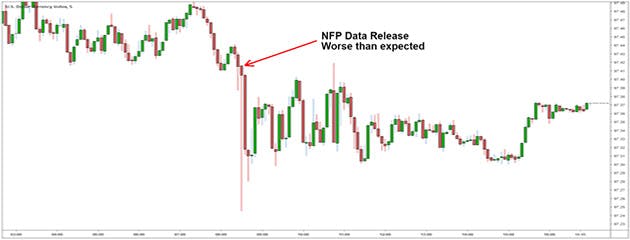This website uses cookies and is meant for marketing purposes only.

Various news releases are known to move currency pairs in the forex market, and this makes them subject to traders’ anticipation and scrutiny. After all, if traders had good reason to believe prices were due to surge, for instance, they would stand to benefit by opening a buy deal on a relevant forex pair. In reality, it’s never clear from the outset what the impact of a news report is going to be, so it’s hard to ever say with certainty that, say, a spike in the US dollar is due to come off the heels of a given data release.
The most watched data release in the forex market is called the US nonfarm payroll (NFP) report, which is sent out by the US Bureau of Labor Statistics (BLS) at 8.30 a.m. on the first Friday of every month. Just the fact that so many people around the world agree to its significance, opening trades based on its messages, ensures that, through a self-fulfilling prophecy, the report does in fact shake up forex prices considerably. Since the global forex market doesn’t go to sleep at all during the week (until Friday 5 p.m. EST), currency traders on all spots of the globe are able to devote their full attention to the NFP release. As a result, every one of the major currency pairs sees pip action in response to the NFP.
However, if the nature of the report’s impact on currencies is never clear, how can there be a sound, reliable way of reaping advantage from its appearance? In order to figure this out, let’s discuss what the NFP report actually tells us.
This document contains plenty of information gathered from two different surveys carried out by the BLS in the previous month. One of the surveys, called the Establishment Survey, investigates businesses and, specifically, the number of new jobs they added during the course of the month. It also tells us about the industries that produced those jobs, how much money workers in those industries earned per hour, and how many hours those employees worked. Due to widespread interest in the headline number of new jobs created, it’s often the case that the meaning of “nonfarm payroll report” in the parlance of analysts is the Establishment Survey.
However, another headline statistic in the NFP report is found in the other survey conducted by the BLS, which is called the Household Survey. This is the study that informs us of the unemployment rate in the USA, which is a crucial factor analysts consider when trying to understand the economic trajectory of the nation. The Household Survey goes deeper than the mere percentage figure and reveals the demographic groups experiencing unemployment the most intensely. Through reading the survey, strategists can get an idea of which races, genders, and age groups have been suffering the most from joblessness in the previous month. As a result, it becomes possible to identify trends in unemployment that might be set to continue. Other trends that can be comprehended better with the help of the NFP report include those in inflation, GDP, and economic growth.
All of the abovementioned trends touch the financial markets very closely but, putting aside the more subtle lessons of the NFP, it’s generally considered bullish for the US dollar if the number of new jobs is high. This is because more jobs mean more money for consumers to spend, which means a dynamic and healthy economy, and this, in turn, means things look good for the national currency. The definition of a high jobs reading depends more on how it measured up to expectations than on how it compared to some standard figure. A low unemployment rate bodes well for the economy and the dollar because it means more Americans have the wherewithal to spend.
It follows from the above that, in a case where a lot more jobs were created in the previous month than people expected, and, in addition, unemployment numbers were stable or improving, traders would derive a buy a signal for the USD dollar. A case in point would be traders’ reaction to the NFP report released on January 5th, 2024. The report showed that 216,000 new jobs were created in December 2023, beating estimates of 170,000, and that wage growth was higher than anticipated too. Unemployment remained unchanged over the previous month. It was understandable that traders took the information as dollar bullish, which is why the USD climbed after the release.
On February 2nd, the data for January came out, shocking traders with a huge payroll figure of 353,000, almost doubling analysts’ forecasts, and also revising last month's figure up from 216,000 to 333,000. Wage growth grew even more, and unemployment was unmoved. Predictably, the dollar’s initial reaction was to jump sharply against its competitors.
Moving on to March, however, the picture changed rapidly. The headline jobs number was 275,000, (better than the expected 200,000), but the unemployment rate ticked up to 3.9%. In addition, wages stopped the pace of their growth, and the previous month’s jobs figure of 353,000 was revised down dramatically to only 229,000. In traders’ minds, this proved the economy was not steaming along as robustly as they had believed, so they decided to sell off the dollar, which sunk on the news.
In the chart below, you can observe the effect on the dollar index (DXY: a gauge of the dollar’s strength against its peers) when dramatically low payroll numbers came out on another occasion. As you see, the first bar that appears after the NFP release at 8.30 a.m. is a long red one, signifying a pronounced bearish price drop for the USD.

Another facet of traders’ decision-making in selling off the dollar in March 2024 was that, since the economy was apparently cooling more quickly than people had anticipated, “the Fed is getting closer to mission accomplished, calming the hot jobs market that led to high inflation”, in the words of Comerica Bank’s Bill Adams. In the event the Fed would finally agree to lower interest rates, this would normally be viewed as bearish for the greenback, which gave traders another reason to sell the dollar.
An approach to trading forex based on the NFP would be the following. Do nothing but observe for the first 15 minutes after the report’s release: This is vital because the initial reaction of the market is often quite fleeting. We couldn’t know, so early on, which way prices are destined to head off the back of the news. In addition, a premature entry could easily lead to your deal getting stopped out by erratic price jumps. Presuming you’re using 15-minute bars on your price charts, watch very closely as the second and third bars form. What you’re searching for is a price bar – called an inside bar – that is totally contained within the range of the previous bar, extending neither above nor below it. This would show us prices are consolidating after the initial volatility. Be prepared to wait a little while before positively identifying an inside bar.
Once you do identify one, you have a basis upon which to produce trading signals for your deal. When you see a new bar close above or below the inside bar, you have reason to believe prices are choosing a direction. Thus, a new bar closing above the level of the inside bar would be a signal to buy, and, if it closes below the inside bar, it would be a sell signal. Alternatively, if you are more hot-blooded, you could forget about waiting for the new bar to actually close above the inside bar. Instead, you could open your deal as soon as the new bar extends above or below the inside bar.
Refer back to the dollar index chart above and you’ll see that, after the initial deep drop in the DXY that was sparked by the NFP (bar 1), the next bar (bar 2) is a shorter red one, indicating that prices continued to plummet in the next session, but less so. The bar following that one (bar 3), which is tiny and green, displays a price range that’s completely included within its predecessor’s range, giving it the status of an inside bar. The hot-blooded version of our NFP trading strategy would suggest opening a buy deal as soon as bar 4 extends above bar 3. In this case, such a deal would have led to large gains because bar 4 ended up climbing a very long way up – over halfway the length of bar 1. In other words, it turned out that prices had indeed chosen a direction once bar 4 was underway.
Can it happen that, after patiently waiting for an inside bar to appear on your chart, and then faithfully trading in the direction prices head, that you still find yourself on the wrong side of the market? Yes, it certainly can. Even after having chosen a direction, prices could still lead you astray by coming to a halt and setting off in the opposite direction. The best way of dealing with the uncertainty is by putting a stop loss order on your deal, which automatically closes it when prices drop a certain number of pips below their starting point.
We have learned about the very real opportunity that forex traders spy in the NFP release every month, and about the general pattern of traders’ reactions to the new data. We have also learned that traders’ responses to the NFP tend to be more nuanced than a mere knee-jerk reaction to high payroll numbers, absorbing, as they do, the finer details of the BLS’s data and also extraneous economic trends like Fed monetary policy. It can therefore be beneficial to read a wide range of market analysis before going ahead and trading the NFP.
The materials contained on this document should not in any way be construed, either explicitly or implicitly, directly or indirectly, as investment advice, recommendation or suggestion of an investment strategy with respect to a financial instrument, in any manner whatsoever. Any indication of past performance or simulated past performance included in this document is not a reliable indicator of future results. For the full disclaimer click here.
Join iFOREX to get an education package and start taking advantage of market opportunities.